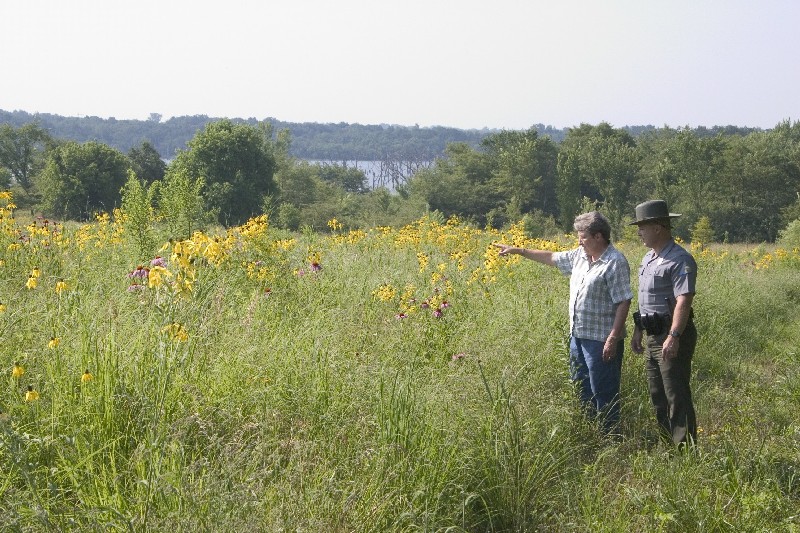| COOPERATIVE CONSERVATION CASE STUDY | | Missouri Conservation Reserve Enhancement Program | | Targeting Public Water Supplies Improves Water Quality | | Location: Northeastern/Mid-Atlantic | | Project Summary: The Missouri Conservation Reserve Enhancement Program (CREP) provides incentives to farmers to restore riparian buffers to reduce sediment, pollutant, and bacterial loading of waterways. |
|  | | Mitch Hoover, Missouri Department of Conservation agent, and Peggy Rapp, Clinton County Farm Service Agency conservation program technician, survey wildflowers on an eight acre tract enrolled in MoCREP. The wildflowers were interseeded with warm season grasses to improve wildlife habitat and water quality. (FSA Photo)
|
|
Resource Challenge
Aquatic and terrestrial habitats in Missouri’s prairie region have slowly degraded over time. Early settlers drained wetlands, tilled marginal cropland, removed streamside forests, and created deep channels in waterways that destroyed the structure fish need for breeding, food, and shelter. Riparian buffers, strips of vegetation along lakes, streams, and rivers, enhance water quality by filtering out as much as 90 percent of the sediment, nutrients, pesticides and other chemicals that reach the water. They also provide valuable wildlife habitat and shade.
In Missouri, a group of federal, state, and private organizations plan to restore 50,000 acres of riparian buffers in 36 counties, targeting waterways that feed 58 public drinking water supplies that collectively serve more than 375,000 Missouri citizens.
The primary tool for restoring buffers is the CREP. This voluntary Federal program provides incentives to farmers to retire highly erodible cropland and replace it with trees, grass, and shrubs to reduce the amount of sediment, pollutants, and potential diseasecausing organisms that enter the water. In some cases, buffers help communities avoid the need to construct costly water treatment systems.
Under CREP, states cost-share the federal funds, establish project criteria and cost-share practices, provide technical assistance, and select the target area for projects.
| Examples of Key Partners
USDA Farm Service Agency, USDA Natural Resources Conservation Service, State Departments of Natural Resources, Agriculture, Natural Resources, and Conservation, local Public Drinking Water Districts, Missouri University and Extension, Missouri Soil and Water Conservation Districts, and landowners, farmers and ranchers.
|
| Results and Accomplishments
Buffers have been created on 13,565 acres of Missouri farmlands. Partners are actively promoting the CREP and have field staff assisting farmers with project planning and implementation. The State is also conducting an extensive public awareness program through direct mailings, newsletters, the press, and “town hall” style meetings.
By targeting many small drinking water systems, the project could potentially have immediate results. The State plans to emphasize larger drinking water systems and expand participation in the CREP, targeting landowners around larger reservoirs to meet enrollment goals.
A Core CREP Team meets periodically to assess results and address challenges.
|
|
Innovation/Highlight A federal, state, and local partnership is improving drinking water quality, wildlife habitat, and wetland health by targeting farmers with the financial and technical assistance needed to construct and maintain vegetation buffers along waterways. |
| |
 Land Conservation
Land Conservation Conservation
Conservation Arkansas
Arkansas California
California Colorado
Colorado Houston
Houston Idaho
Idaho Louisiana
Louisiana Maine
Maine Mississippi
Mississippi Habitat
Habitat
 Land Conservation
Land Conservation Conservation
Conservation Arkansas
Arkansas California
California Colorado
Colorado Houston
Houston Idaho
Idaho Louisiana
Louisiana Maine
Maine Mississippi
Mississippi Habitat
Habitat